Characteristics of Carbon Nanotube Cold Cathode Triode Electron Gun Driven by MOSFET Working at Subthreshold Region
Abstract
:1. Introduction
2. Experimental
3. Results and Discussion
3.1. Characterization of the Carbon Nanotube Cathode
3.2. Characteristics of Triode CNT Cold Cathode Electron Gun
3.3. I-V Characteristics of Triode CNT Cold Cathode Electron Gun in Series with MOSFET
3.4. Current Stability of Triode CNT Cold Cathode Electron Gun in Series with MOSFET
4. Conclusions
Author Contributions
Funding
Data Availability Statement
Conflicts of Interest
References
- Iijima, S. Helical Microtubules of Graphitic Carbon. Nature 1991, 358, 56–58. [Google Scholar] [CrossRef]
- Diao, J.J.; An, L.B.; Chang, C.R. Progress on the Application of Carbon Nanotubes in Typical Micro and Nano Electronic Devices. New Carbon. Mater. 2016, 31, 149–156. [Google Scholar]
- Li, Y.T.; Sun, K.; Luo, D.; Wang, Y.M.; Han, L.; Liu, H.; Guo, X.L.; Yu, D.L.; Ren, T.L. A Review on Low-Dimensional Novel Optoelectronic Devices Based on Carbon Nanotubes. AIP Adv. 2021, 11, 110701. [Google Scholar] [CrossRef]
- Chen, J.T.; Chang, X.Y.; Wu, S.D.; Ren, H.; Zhu, Y.R.; Yang, B.J.; Zhao, Y.; Chen, J.B.; Li, Y. “Double-High” Field Electron Emission of Screen-Printed Carbon Nanotube Cathodes. Vacuum 2023, 217, 112517. [Google Scholar] [CrossRef]
- Shah, K.A.; Tali, B.A. Synthesis of Carbon Nanotubes by Catalytic Chemical Vapour Deposition: A Review on Carbon Sources, Catalysts and Substrates. Mater. Sci. Semicond. Process 2016, 41, 67–82. [Google Scholar] [CrossRef]
- Gupta, N.; Gupta, S.M.; Sharma, S.K. Carbon Nanotubes: Synthesis, Properties and Engineering Applications. Carbon. Lett. 2019, 29, 419–447. [Google Scholar] [CrossRef]
- Li, N.N.; Zhang, H.; Yan, F.; Luo, Y. Carbon Nanotube-Based High-Current Nanoscale Air-Channel Electronic Devices for Low-Power Ultrafast Electronics. ACS Appl. Nano Mater. 2023, 6, 18926–18933. [Google Scholar] [CrossRef]
- Kim, Y.C.; Park, S.H.; Lee, C.S.; Chung, T.W.; Cho, E.; Chung, D.S.; Han, I.T. A 46-inch Diagonal Carbon Nanotube Field Emission Backlight for Liquid Crystal Display. Carbon 2015, 91, 304–310. [Google Scholar] [CrossRef]
- Xi, M.Q.; Liu, F.; Zhu, X.H.; Li, Y.; Bai, L.; Chen, X.X.; Gong, Y.J.; Guo, Y.; Zhou, Y.G.; Peng, L.M.; et al. High-performance thin-film transistors based on aligned carbon nanotubes for mini- and micro-LED displays. Carbon 2024, 218, 118718. [Google Scholar] [CrossRef]
- Shan, J.; Tucker, A.W.; Lee, Y.Z.; Heath, M.D.; Zhou, O.; Lu, J.P. Stationary Chest Tomosynthesis Using a Carbon Nanotube X-ray Source Array: A Feasibility Study. J. Vac. Sci. Technol. B 2011, 29, 02B106. [Google Scholar] [CrossRef]
- Yuan, X.S.; Zhu, W.W.; Zhang, Y.; Xu, N.S.; Yan, Y.; Wu, J.Q.; Shen, Y.; Chen, J.; She, J.C.; Deng, S.Z. A Fully-Sealed Carbon-Nanotube Cold-Cathode Terahertz Gyrotron. Sci. Rep. 2016, 6, 32936. [Google Scholar] [CrossRef] [PubMed]
- Shi, C.Y.; Luu, D.K.; Yang, Q.M.; Liu, J.; Chen, J.; Ru, C.H.; Xie, S.R.; Luo, J.; Ge, J.; Sun, Y. Recent Advances in Nanorobotic Manipulation Inside Scanning Electron Microscopes. Microsyst. Nanoeng. 2016, 2, 16024. [Google Scholar] [CrossRef] [PubMed]
- Radauscher, E.J.; Gilchrist, K.H.; Di Dona, S.T.; Russell, Z.E.; Piascik, J.R.; Amsden, J.J.; Parker, C.B.; Stoner, B.R.; Glass, J.T. Improved Performance of Field Emission Vacuum Microelectronic Devices for Integrated Circuits. IEEE Trans. Electron. Devices 2016, 63, 3753–3760. [Google Scholar] [CrossRef]
- Sawant, J.; Yu, Y.Y.; Bhotkar, K.; Jung, H.J.; Nam, G.J.; Park, K.C. Development of 3D Tomosynthesis Technique for Nondestructive Technology Application Using Vertically Aligned Carbon Nanotube-Based High-Resolution Cold Cathode Electron Beam. J. Vac. Sci. Technol. B 2023, 41, 033201. [Google Scholar] [CrossRef]
- Yuan, X.S.; Zhang, Y.; Yang, H.; Li, X.Y.; Xu, N.S.; Deng, S.Z.; Yan, Y. A Gridded High-Compression-Ratio Carbon Nanotube Cold Cathode Electron Gun. IEEE Electron. Device Lett. 2015, 36, 399–401. [Google Scholar] [CrossRef]
- Zhang, J.; Xu, J.; Ji, D.X.; Xu, H.; Sun, M.; Wu, L.; Li, X.Y.; Wang, Q.L.; Zhang, X.B. Development of an Electron Gun Based on CNT-cathode for Traveling Wave Tube Application. Vacuum 2021, 186, 110029. [Google Scholar] [CrossRef]
- Hong, J.H.; Kang, J.S.; Park, K.C. Fabrication of a Compact Glass-Sealed X-ray Tube with Carbon Nanotube Cold Cathode for High-Resolution Imaging. J. Vac. Sci. Technol. B 2018, 36, 02C109. [Google Scholar] [CrossRef]
- Liu, X.C.; Li, Y.X.; Xiao, J.F.; Zhao, J.Z.; Li, C.; Li, Z.J. Enhanced field emission stability of vertically aligned carbon nanotubes through anchoring for X-ray imaging applications. J. Mater. Chem. C 2023, 11, 2505–2513. [Google Scholar] [CrossRef]
- Gunnell, E.T.; Franceschi, D.K.; Inscoe, C.R.; Hartman, A.; Goralski, J.L.; Ceppe, A.; Handly, B.; Sams, C.; Fordham, L.A.; Lu, J.P.; et al. Initial Clinical Evaluation of Stationary Digital Chest Tomosynthesis in Adult Patients with Cystic Fibrosis. Eur. Radiol. 2018, 29, 1665–1673. [Google Scholar] [CrossRef]
- Jiang, R.R.; Liu, J.L.; Zhao, P.Y.; Yang, K.Q.; Zhao, J.; Chen, T.; Gong, Y.B.; Zeng, B.Q. Design of a Ka-Band Traveling Wave Tube Using Low Turn-On Field Emission Electron Source Made by Carbon Nanotubes. IEEE Trans. Plasma Sci. 2022, 50, 29–35. [Google Scholar] [CrossRef]
- Bhotkar, K.; Yu, Y.Y.; Sawant, J.; Patil, R.; Park, K.C. Novel Technique to Control the Focal Spot Size Using Carbon Nanotube Based Cold Cathode Electron Beam (C-beam) Architecture. J. Vac. Sci. Technol. B 2023, 41, 023202. [Google Scholar] [CrossRef]
- Wang, Y.; Zhang, P.; Yu, S.; Wang, L.; Chen, Z. Fast microfocus cold cathode X-ray tube based on carbon nanotube array. IVEC 2023, 2023, 1–2. [Google Scholar]
- Han, J.S.; Lee, S.H.; Lee, C.J. High-Performance Field Electron Emitters Fabricated Using a Free-Standing Carbon Nanotube Film. IEEE J. Electron. Devices Soc. 2022, 10, 402–407. [Google Scholar] [CrossRef]
- Han, J.S.; Lee, S.H.; Go, H.; Kim, S.J.; Noh, J.H.; Lee, C.J. High-Performance Cold Cathode X-ray Tubes Using a Carbon Nanotube Field Electron Emitter. ACS Nano 2022, 16, 10231–10241. [Google Scholar] [CrossRef]
- Yu, Y.Y.; Park, K.C. Gate Offset and Emitter Design Effects of Triode Cold Cathode Electron Beams on Focal Spot Sizes for X-ray Imaging Techniques. J. Vac. Sci. Technol. B 2022, 40, 022204. [Google Scholar] [CrossRef]
- Nordheim, L.W. The Effect of the Image Force on the Emission and Reflexion of Electrons by Metals. Proc. R. Soc. A Math. Phys. Eng. Sci. 1928, 121, 626–639. [Google Scholar]
- Karain, W.I.; Knight, L.V.; Allred, D.D.; Reyes-Mena, A. Emitted Current Instability from Silicon Field Emission Emitters due to Sputtering by Residual Gas Ions. J. Vac. Sci. Technol. A 1994, 12, 2581–2585. [Google Scholar] [CrossRef]
- Islam, A.E.; Fairchild, S.B.; Maruyama, B.; Razeghi, M.; Ghazinejad, M.; Bayram, C.; Yu, J.S. Thermal Instability of Field Emission from Carbon Nanotubes Studied Using Multi-Physics Simulation by Considering Space Charge Effect. In Proceedings of the Proc. SPIE 9552, Carbon Nanotubes, Graphene, and Emerging 2D Materials for Electronic and Photonic Devices VIII, San Diego, CA, USA, 9–12 August 2015; Volume 9552, p. 95520B. [Google Scholar]
- Yeong, K.S.; Thong, J.T.L. Effects of Adsorbates on the Field Emission Current from Carbon Nanotubes. Appl. Surf. Sci. 2004, 233, 20–23. [Google Scholar] [CrossRef]
- Sethi, A.; Emami, B.; Small, W.; Thomas, T.O. Intraoperative Radiotherapy with INTRABEAM: Technical and Dosimetric Considerations. Front. Oncol. 2018, 8, 74. [Google Scholar] [CrossRef]
- Foster, J.E.; Williams, G.J.; Patterson, M.J. Characterization of an Ion Thruster Neutralizer. J. Propuls. Power 2007, 23, 828–835. [Google Scholar] [CrossRef]
- Cho, Y.R.; Hwang, C.S.; Song, Y.H.; Ahn, S.D.; Chung, C.H.; Lee, J.H.; Cho, K.I. Low-Voltage Operating Triode-Type Field Emission Displays Controlled by Amorphous–Silicon Thin-Film Transistors. Jpn. J. Appl. Phys. 2002, 41, 5745–5748. [Google Scholar] [CrossRef]
- Yang, W.J.; She, J.C.; Deng, S.Z.; Xu, N.S. Field Emission from a MOSFET-Controlled ZnO-Nanowire Cold Cathode. IEEE Trans. Electron. Devices 2012, 59, 3641–3646. [Google Scholar] [CrossRef]
- Cheng, H.C.; Hong, W.K.; Tarntair, F.G.; Chen, K.J.; Lin, J.B.; Chen, K.H.; Chen, L.C. Integration of Thin Film Transistor-Controlled Carbon Nanotubes for Field Emission Devices. Electrochem. Solid-State Lett. 2001, 4, H5–H7. [Google Scholar] [CrossRef]
- Bae, N.Y.; Bae, W.M.; Ha, A.N.; Nakamoto, M.; Jang, J.; Park, K.C. Low-voltage Driven Carbon Nanotube Field Emission Lamp. Curr. Appl. Phys. 2011, 11, S86–S89. [Google Scholar] [CrossRef]
- Deng, S.Z.; Wang, K.; Chen, J.; Zhang, Y.Q.; Xu, N.S. Study of a Microprocessor-Based Technique for Improving the Uniformity of a Field-Emission Flat-Panel Display. J. Vac. Sci. Technol. B 2003, 21, 523–526. [Google Scholar] [CrossRef]
- Guo, Y.J.; Wang, J.F.; Li, B.H.; Zhang, Y.; Deng, S.Z.; Chen, J. Achieving High Current Stability of Gated Carbon Nanotube Cold Cathode Electron Source Using IGBT Modulation for X-ray Source Application. Nanomaterials 2022, 12, 1882. [Google Scholar] [CrossRef] [PubMed]
- Lee, J.W.; Jeong, J.W.; Kang, J.T.; Kim, J.W.; Park, S.; Jeon, H.; Go, E.; Ahn, Y.; Kim, D.J.; Song, Y.H. Stabilized and Equalized Field-Emission Currents from Carbon Nanotube Emitters by Cascade Active-Current-Control. IEEE Trans. Electron. Devices 2020, 67, 1192–1197. [Google Scholar] [CrossRef]
- Zhang, Y.; Tan, Y.M.; Wang, L.Z.; Li, B.H.; Ke, Y.L.; Liao, M.X.; Xu, N.S.; Chen, J.; Deng, S.Z. Electron Emission and Structure Stability of Carbon Nanotube Cold Cathode Driven by Millisecond Pulsed Voltage. Vacuum 2020, 172, 109071. [Google Scholar] [CrossRef]
- Wang, Z.L.; Gao, R.P.; de Heer, W.A.; Poncharal, P. In situ imaging of field emission from individual carbon nanotubes and their structural damage. Appl. Phys. Lett. 2002, 80, 856–858. [Google Scholar] [CrossRef]
- Cardenas, J.F. Protonation and Sonication Effects on Aggregation Sensitive Raman Features of Single Wall Carbon Nanotubes. Carbon. 2008, 46, 1327–1330. [Google Scholar] [CrossRef]
- Zhang, P.; Fan, J.Y.; Wang, Y.Q.; Dang, Y.; Heumann, S.; Ding, Y.X. Insights into the Role of Defects on the Raman Spectroscopy of Carbon Nanotube and Biomass-derived Carbon. Carbon 2024, 222, 118998. [Google Scholar] [CrossRef]
- Kim, W.S.; Oki, H.; Kinoshita, A.; Murakami, K.; Abo, S.; Wakaya, F.; Takai, M. Relationship Between Field-Emission Characteristics and Defects Measured by Raman Scattering in Carbon-Nanotube Cathodes Treated by Plasma and Laser. J. Vac. Sci. Technol. B 2008, 26, 760–763. [Google Scholar] [CrossRef]
- Wei, G. Emission Property of Carbon Nanotube with Defects. Appl. Phys. Lett. 2006, 89, 143111. [Google Scholar] [CrossRef]
- Ni, Z.C.; Ishaq, A.; Yan, L.; Gong, J.L.; Zhu, D.Z. Enhanced Electron Field Emission of Carbon Nanotubes by Si Ion Beam Irradiation. J. Phys. D 2009, 42, 075408. [Google Scholar] [CrossRef]
- Li, Z.J.; Yang, X.X.; He, F.; Bai, B.; Zhou, H.; Li, C.; Dai, Q. High Current Field Emission from Individual Non-linear Resistor Ballasted Carbon Nanotube Cluster Array. Carbon 2015, 89, 1–7. [Google Scholar] [CrossRef]
- Ahn, Y.; Kim, S.J.; Jeong, J.W.; Park, S.; Kim, J.W.; Go, E.; Lee, J.W.; Kang, J.T.; Yun, K.N.; Choi, S.; et al. Overall Control of Field Emission from Carbon Nanotube Paste-emitters through Macro-Geometries for High-Performance Electron Source Applications. Carbon 2022, 189, 519–529. [Google Scholar] [CrossRef]
- Ortiz-Conde, A.; Sánchez, F.J.G.; Liou, J.J.; Cerdeira, A.; Estrada, M.; Yue, Y. A Review of Recent MOSFET Threshold Voltage Extraction Methods. Microelectron. Reliab. 2002, 42, 583–596. [Google Scholar] [CrossRef]
- Michael, J.E.; Jeffrey, S.R. Probability and Statistics: The Science of Uncertainty; Checkmark Books: New York, NY, USA, 2005; p. 205. [Google Scholar]
- Jeong, J.W.; Kim, J.W.; Kang, J.T.; Choi, S.; Ahn, S.; Song, Y.H. A Vacuum-sealed Compact X-ray Tube Based on Focused Carbon Nanotube Field-emission Electrons. Nanotechnology 2013, 24, 085201. [Google Scholar] [CrossRef]
- Sharma, A.; Kim, H.S.; Kim, D.W.; Ahn, S. A Carbon Nanotube Field-emission X-ray Tube with a Stationary Anode Target. Microelectron. Eng. 2016, 152, 35–40. [Google Scholar] [CrossRef]
- Lee, J.W.; Jeon, H.; Go, E.; Song, Y.H.; Jeong, J.W.; Kang, J.T.; Kim, J.W.; Choi, Y.C.; Park, S.; Kim, S.; et al. An Active Current-control Unit Composed of Cascade Transistors for Extremely Stabilizing Emission Currents from Carbon Nanotube Field Emitters. In Proceedings of the 2017 30th International Vacuum Nanoelectronics Conference (IVNC), Regensburg, Germany, 10–14 July 2017; Volume 2017, pp. 208–209. [Google Scholar]
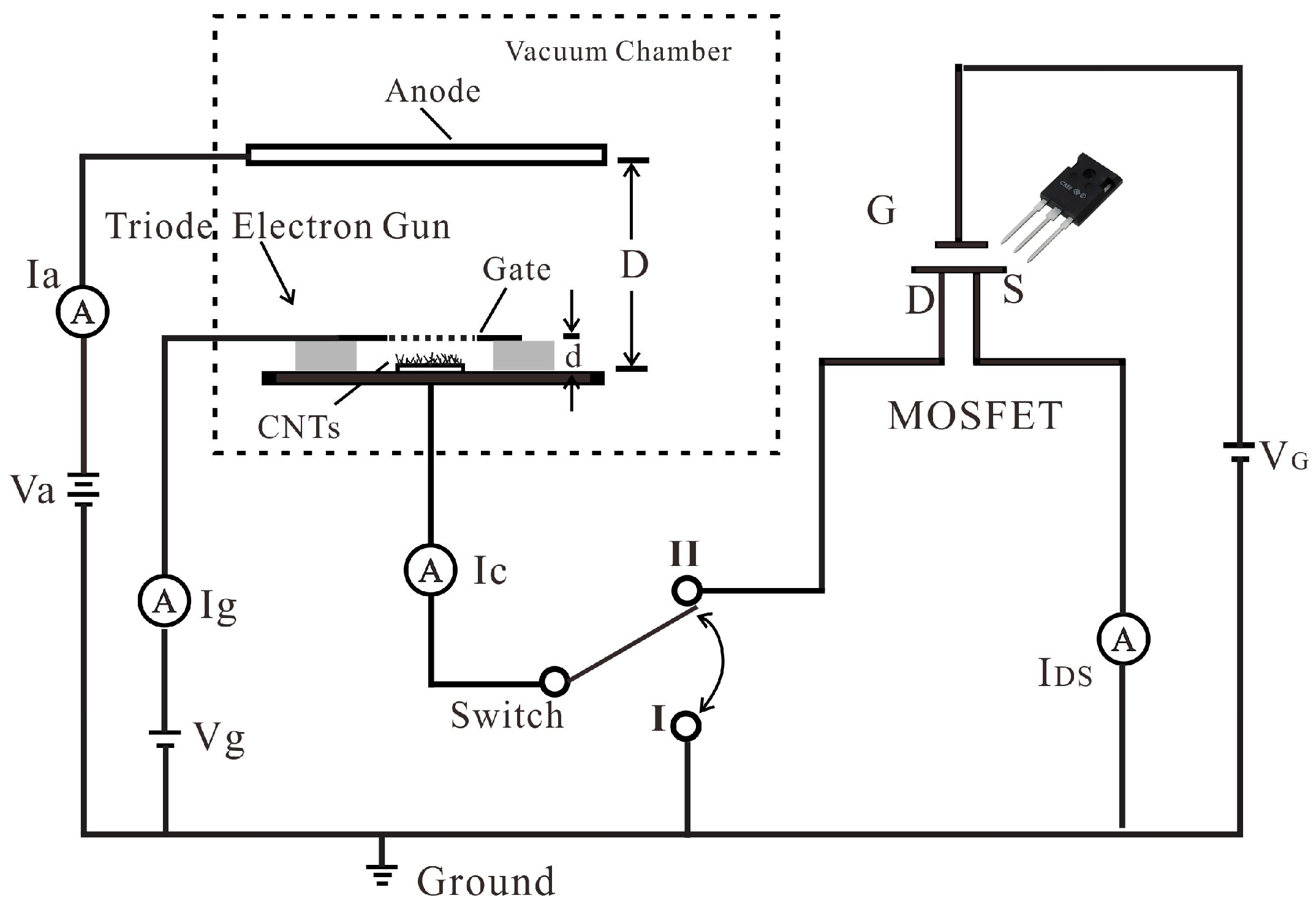
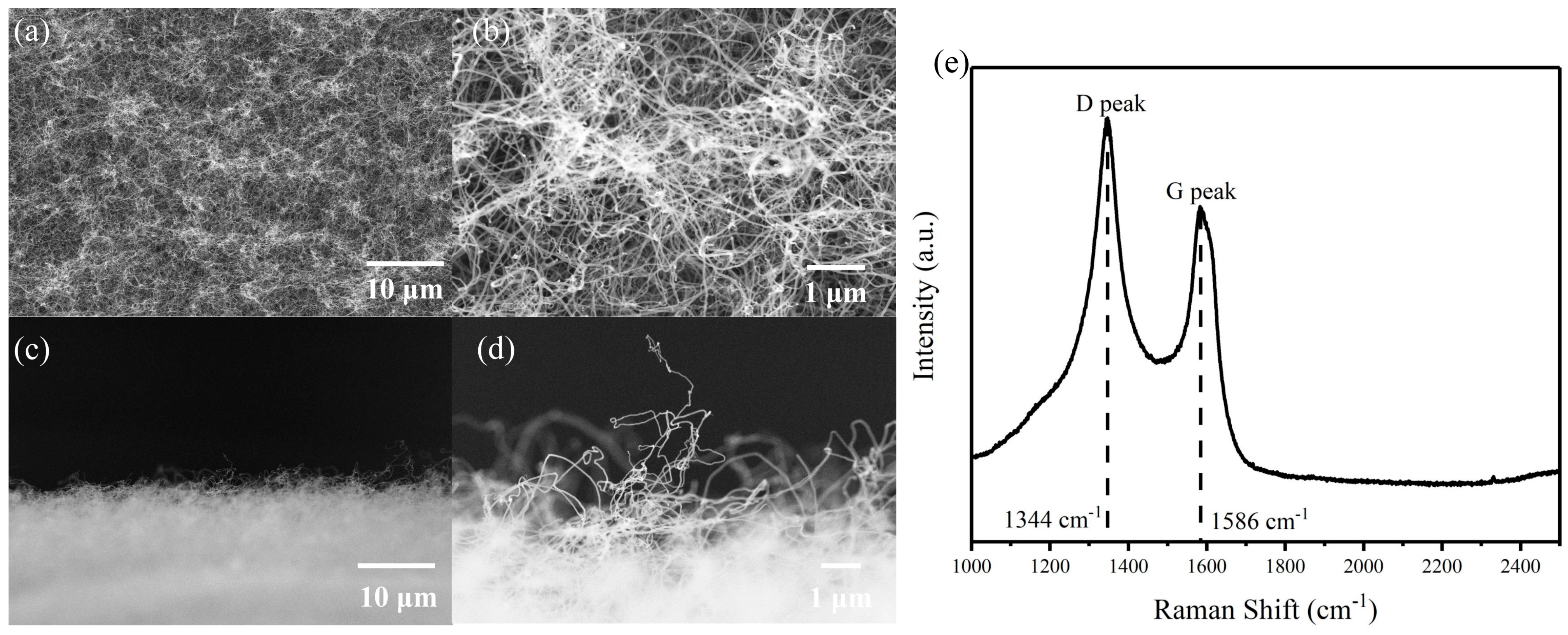



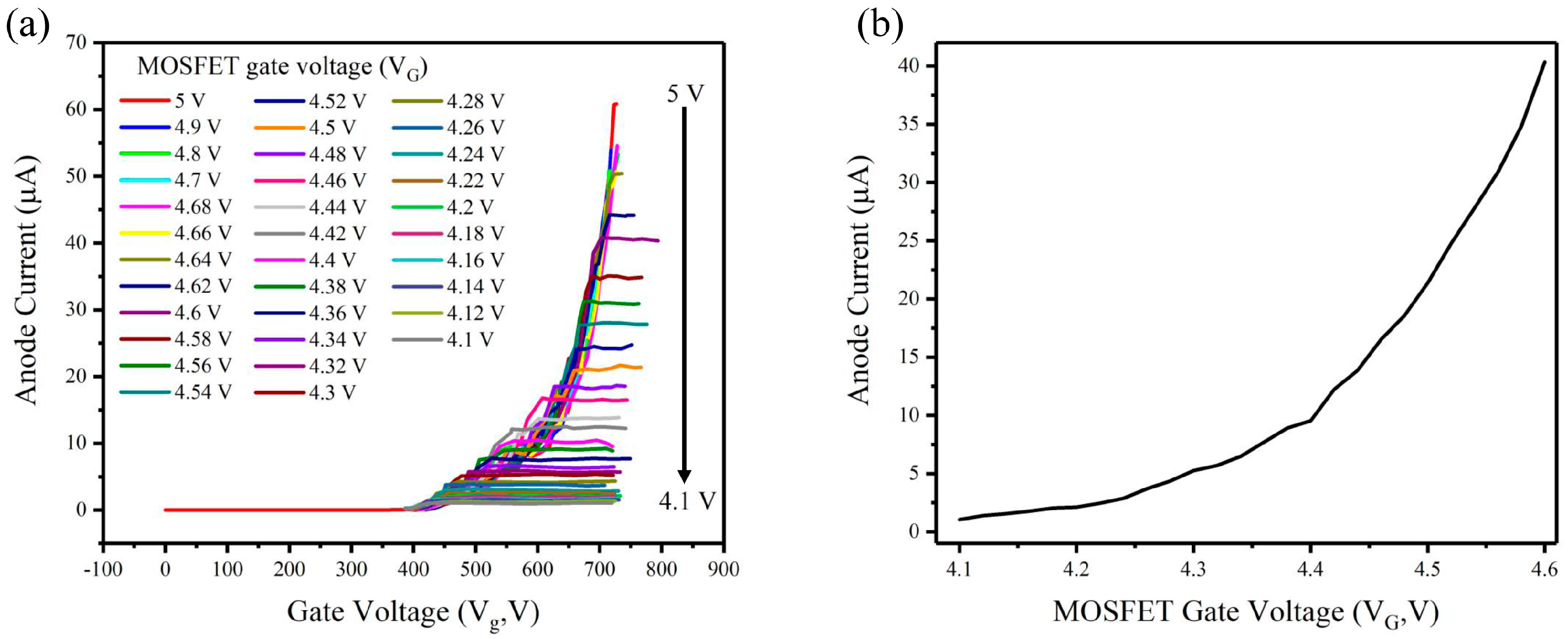
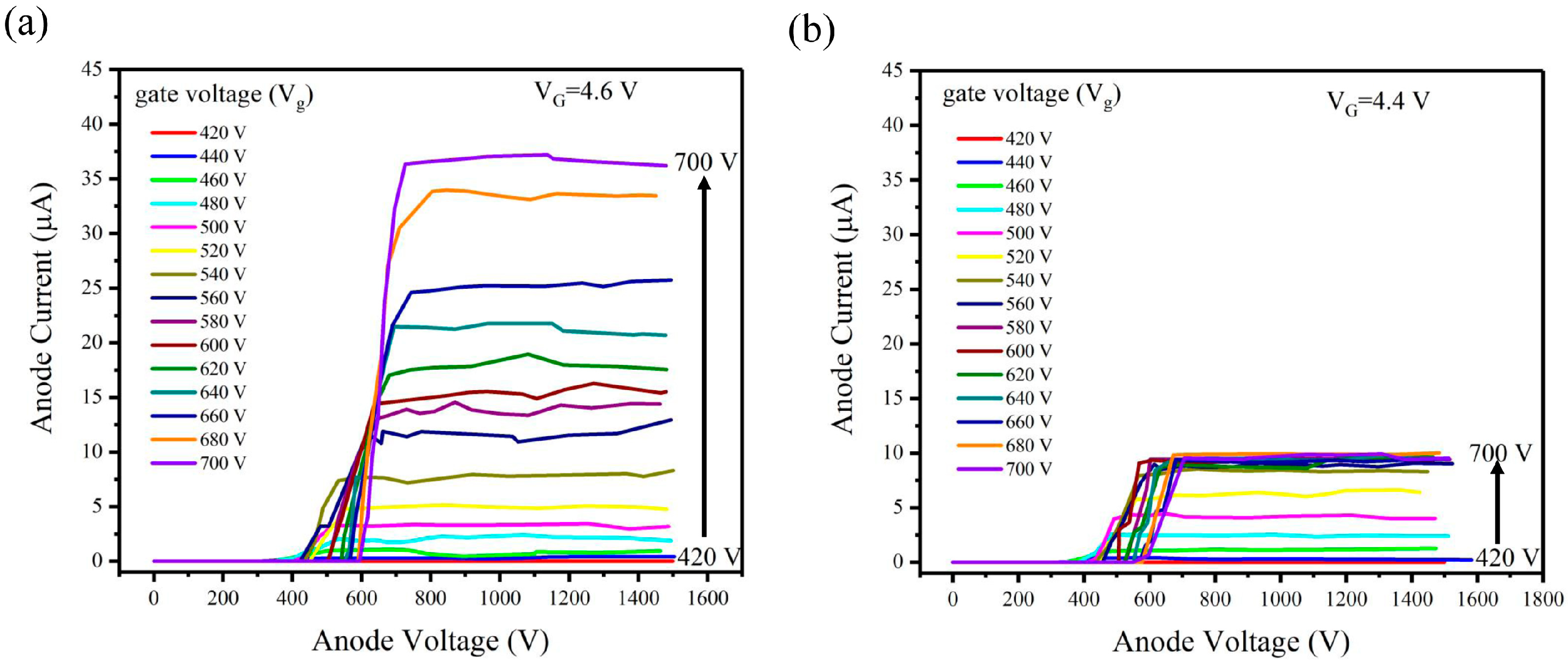
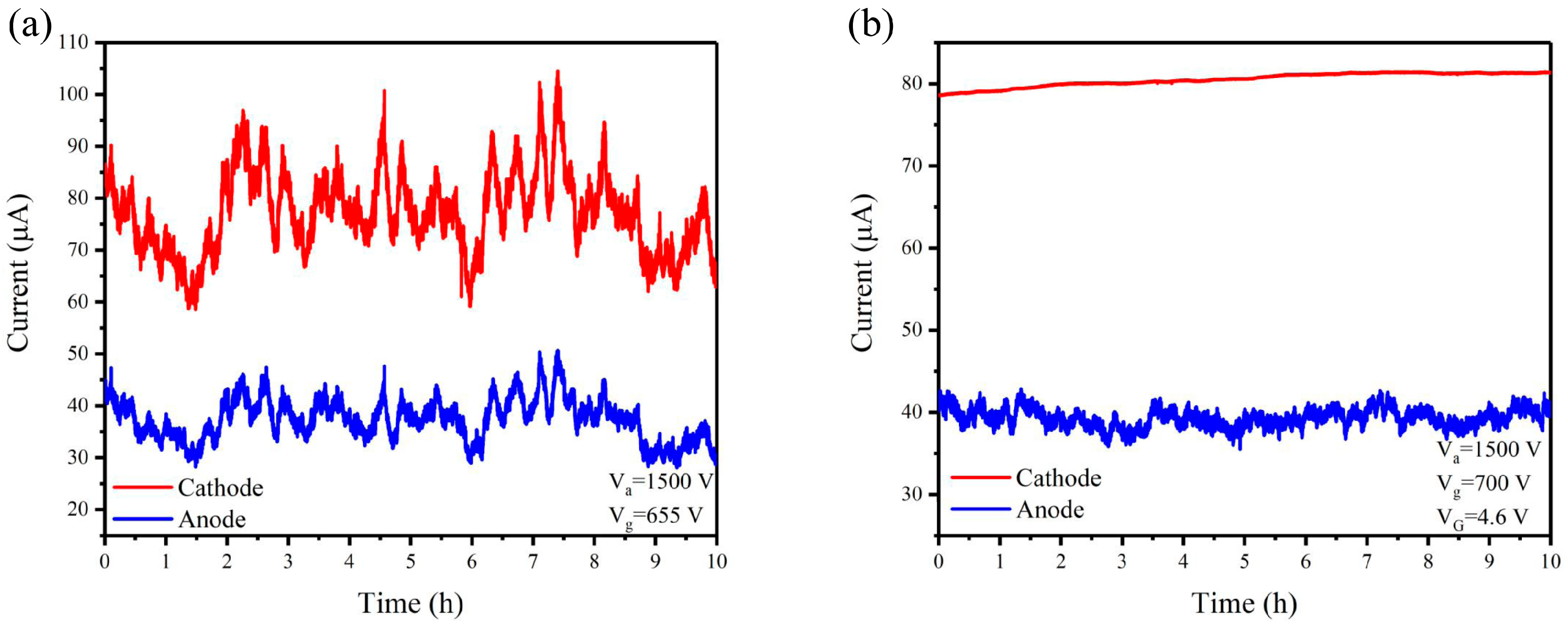
| Cathode | Electron Gun Structure | Control Unit | Active Device Connection Method | Operation Mode | Operation Current | Current Fluctuation | Ref. |
|---|---|---|---|---|---|---|---|
| Mo-tip | Triode | a-Si TFT | Integrated | pulse | ~5 µA (cathode) | / | [32] |
| ZnO NW | Diode | MOSFET | Integrated | direct current | ~1.15 µA (cathode) | 3.2% over 3 h | [33] |
| Carbon Nanotubes | Triode | TFT | Integrated | direct current | 11 µA (anode) | <2% over 1 h | [34] |
| Carbon Nanotubes | Triode | IGBT | Discrete | direct current | ~50 µA (cathode) | 0.22% over ~0.8 h | [36] |
| Carbon Nanotubes | Triode | Two transistors | Discrete | direct current | 1.66 mA (cathode) | 0.13% over 2000 s | [38] |
| Carbon Nanotubes | Triode | Two transistors | Discrete | direct current | 1.6 mA (anode) | 0.16% over 2000 s | [38] |
| Carbon Nanotubes | Triode | HV-MOSFET | Discrete | pulse | ~10 mA (cathode) | / | [50] |
| Carbon Nanotubes | Triode | Current controller | Discrete | pulse | ~10 mA (cathode) | / | [51] |
| Carbon Nanotubes | Triode | Two transistors | Discrete | direct current | ~2 mA (cathode) | <0.1% over 600 s | [52] |
| Carbon Nanotubes | Triode | MOSFET | Discrete | direct current | ~80 µA (cathode) | 0.87% over 10 h | this work |
| Carbon Nanotubes | Triode | MOSFET | Discrete | direct current | ~40 µA (anode) | 2.3% over 10 h | this work |
Disclaimer/Publisher’s Note: The statements, opinions and data contained in all publications are solely those of the individual author(s) and contributor(s) and not of MDPI and/or the editor(s). MDPI and/or the editor(s) disclaim responsibility for any injury to people or property resulting from any ideas, methods, instructions or products referred to in the content. |
© 2024 by the authors. Licensee MDPI, Basel, Switzerland. This article is an open access article distributed under the terms and conditions of the Creative Commons Attribution (CC BY) license (https://creativecommons.org/licenses/by/4.0/).
Share and Cite
Guo, Y.; Li, B.; Zhang, Y.; Deng, S.; Chen, J. Characteristics of Carbon Nanotube Cold Cathode Triode Electron Gun Driven by MOSFET Working at Subthreshold Region. Nanomaterials 2024, 14, 1260. https://doi.org/10.3390/nano14151260
Guo Y, Li B, Zhang Y, Deng S, Chen J. Characteristics of Carbon Nanotube Cold Cathode Triode Electron Gun Driven by MOSFET Working at Subthreshold Region. Nanomaterials. 2024; 14(15):1260. https://doi.org/10.3390/nano14151260
Chicago/Turabian StyleGuo, Yajie, Baohong Li, Yu Zhang, Shaozhi Deng, and Jun Chen. 2024. "Characteristics of Carbon Nanotube Cold Cathode Triode Electron Gun Driven by MOSFET Working at Subthreshold Region" Nanomaterials 14, no. 15: 1260. https://doi.org/10.3390/nano14151260





